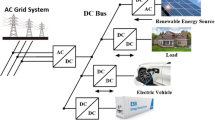Abstract
In this paper, an isolated bidirectional dual active bridge (DAB) converter for interconnecting MVDC and LVDC is proposed. In order to resolve the existing problem of AC distribution such as increasing large-capacity digital loads and distributed generations (DGs), the technology for DC distribution is being studied in Korea. The proposed DAB converter can secure the galvanic isolation for the MV side and the LV side, and direct connection between the extra-high voltage DC distribution and the DC consumer is possible. To develop a 10-level DAB converter for connection to MVDC, a mathematical model for a zero voltage switching (ZVS), a reactive power characteristic, and an inductor design with minimum current ripple is presented. In addition, to verify the validity of the proposed model, software in the loop simulation (SILS) and hardware in the loop simulation (HILS) simulations were used to derive results similar to the actual system, and the accuracy was verified. Finally, economic feasibility analysis of the proposed model and actual system was conducted in terms of research investment cost in Korea.














Similar content being viewed by others
References
Carrasco JM et al (2006) Power-electronic systems for the grid integration of renewable energy sources: a survey. IEEE Trans Ind Elect 53(4):1002–1016
Keane A et al (2013) State-of-the-art techniques and challenges ahead for distributed generation planning and optimization. IEEE Trans Power Syst 28(2):1493–1502
Xu S, Xue Y, Chang L (2021) Review of power system support functions for inverter-based distributed energy resources-standards, control algorithms, and trends. IEEE Open J Power Elect 2:88–105
Hatziargyriou N, Asano H, Iravani R, Marnay C (2007) Microgrids. IEEE Power Energy Mag 5(4):78–94
Cecati C, Citro C, Siano P (2011) Combined operations of renewable energy systems and responsive demand in a smart grid. IEEE Trans Sust Energy 2(4):468–476
Olivares DE et al (2014) Trends in microgrid control. IEEE Trans Smart Grid 5(4):1905–1919
Dragičević T, Lu X, Vasquez JC, Guerrero JM (2016) DC Microgrids—Part II: a review of power architectures, applications, and standardization issues. IEEE Trans Power Elect 31(5):3528–3549
Lotfi H, Khodaei A (2017) AC versus DC microgrid planning. IEEE Trans Smart Grid 8(1):296–304
Blaabjerg F, Teodorescu R, Liserre M, Timbus AV (2006) Overview of control and grid synchronization for distributed power generation systems. IEEE Trans Ind Elect 53(5):1398–1409
Gómez-Expósito A, Mauricio JM, Maza-Ortega JM (2014) VSC-based MVDC railway electrification system. IEEE Trans Power Deliv 29(1):422–431
Yuan C, Haj-ahmed MA, Illindala MS (2015) Protection strategies for medium-voltage direct-current microgrid at a remote area mine site. IEEE Trans Ind Appl 51(4):2846–2853
Magne P, Nahid-Mobarakeh B, Pierfederici S (2012) General active global stabilization of multiloads DC-power networks. IEEE Trans Power Elect 27(4):1788–1798
Anand S, Fernandes BG, Guerrero J (2013) Distributed control to ensure proportional load sharing and improve voltage regulation in low-voltage DC microgrids. IEEE Trans Power Elect 28(4):1900–1913
Pogaku N, Prodanovic M, Green TC (2007) Modeling, analysis and testing of autonomous operation of an inverter-based microgrid. IEEE Trans Power Elect 22(2):613–625
Rocabert J, Luna A, Blaabjerg F, Rodríguez P (2012) Control of power converters in AC microgrids. IEEE Trans Power Elect 27(11):4734–4749
Yadav GNB, Narasamma NL (2014) An active soft switched phase-shifted full-bridge DC–DC converter: analysis, modeling, design, and implementation. IEEE Trans Power Elect 29(9):4538–4550
Musavi F, Craciun M, Gautam DS, Eberle W, Dunford WG (2013) An LLC resonant DC–DC converter for wide output voltage range battery charging applications. IEEE Trans Power Elect 28(12):5437–5445
Kheraluwala MN, Gascoigne RW, Divan DM, Baumann ED (1992) Performance characterization of a high-power dual active bridge DC-to-DC converter. IEEE Trans Ind Appl 28(6):1294–1301
Zhao B, Song Q, Liu W, Sun Y (2014) Overview of dual-active-bridge isolated bidirectional DC–DC converter for high-frequency-link power-conversion system. IEEE Trans Power Elect 29(8):4091–4106
Krismer F, Kolar JW (2012) Efficiency-optimized high-current dual active bridge converter for automotive applications. IEEE Trans Ind Elect 59(7):2745–2760
Zhao T, Wang G, Bhattacharya S, Huang AQ (2013) Voltage and power balance control for a cascaded H-bridge converter-based solid-state transformer. IEEE Trans Power Elect 28(4):1523–1532
Takagi K, Fujita H (2018) Dynamic control and performance of a dual-active-bridge DC–DC converter. IEEE Trans Power Elect 33(9):7858–7866
Everts J, Krismer F, Van den Keybus J, Driesen J, Kolar JW (2014) Optimal ZVS modulation of single-phase single-stage bidirectional DAB AC–DC converters. IEEE Trans Power Elect 29(8):3954–3970
Hou N, Song W, Li Y, Zhu Y, Zhu Y (2019) A comprehensive optimization control of dual-active-bridge DC–DC converters based on unified-phase-shift and power-balancing scheme. IEEE Trans Power Elect 34(1):826–839
Bai H, Mi C (2008) Eliminate reactive power and increase system efficiency of isolated bidirectional dual-active-bridge DC–DC converters using novel dual-phase-shift control. IEEE Trans Power Elect 23(6):2905–2914
She X, Huang AQ, Burgos R (2013) Review of solid-state transformer technologies and their application in power distribution systems. IEEE J Emerg Select Top Power Elect 1(3):186–198
Zhao B, Song Q, Li J, Xu X, Liu W (2018) Comparative analysis of multilevel-high-frequency-link and multilevel-DC-link DC–DC transformers based on MMC and dual-active bridge for MVDC application. IEEE Trans Power Elect 33(3):2035–2049
MVDC Technology Study (2015) Market Opportunities and Economic Impact, TNEI
Acknowledgements
This research was supported by research funds of mokpo national university in 2021.
Author information
Authors and Affiliations
Corresponding author
Additional information
Publisher's Note
Springer Nature remains neutral with regard to jurisdictional claims in published maps and institutional affiliations.
Rights and permissions
About this article
Cite this article
Kim, SW., Lee, HJ. & Kim, DS. Power Converter Design Based on RTDS Implementation for Interconnecting MVDC and LVDC. J. Electr. Eng. Technol. 17, 1751–1760 (2022). https://doi.org/10.1007/s42835-022-01002-9
Received:
Revised:
Accepted:
Published:
Issue Date:
DOI: https://doi.org/10.1007/s42835-022-01002-9




